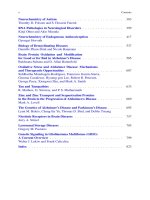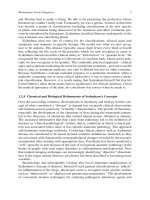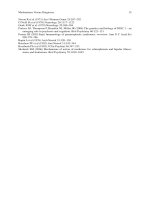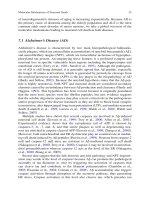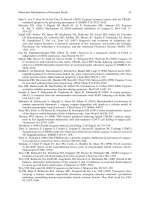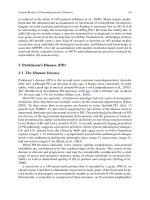Neurochemical Mechanisms in Disease P59 pps
Bạn đang xem bản rút gọn của tài liệu. Xem và tải ngay bản đầy đủ của tài liệu tại đây (135.2 KB, 10 trang )
Biology of Demyelinating Diseases 565
domains: MAG is selectively targeted to periaxonal membranes, PLP to compact
myelin, CNP to noncompact regions of the myelin internode, and MBP mRNA
to oligodendrocyte processes (Trapp et al., 2004). As described by Yakovlev and
Lecours (1966), myelination takes place until adult age and occurs at different ages
according to the area, the latest being the prefrontal area and the associative areas.
Thus leukodystrophies may start clinically in adulthood (Baumann and Turpin,
2000).
Axonal damage secondary to myelin loss is a major cause of sensory, motor, and
cognitive disabilities in adult MS (Bjartmar and Trapp, 2001). The lack of myelin
recovery may be due primarily to deficiency in the genesis of OPCs and in their
maturation in the adult CNS (Franklin, 2002; Stangel and Hartung, 2002). Limited
myelin regeneration is observed in early demyelinating lesions in MS (Wolswijk,
1998).
Possible explanations for remyelination failure in MS (Franklin, 2002; Stangel
and Hartung, 2002) can be the inadequate recruitment of OPCs (Keirstead et al.,
1998) or the inability of OPCs to turn into myelinating oligodendrocytes. Thus,
studies aiming at identifying factors involved in OPC differentiation during remyeli-
nation are of great interest. Guidance molecules Semaphorin 3A and 3F, already
known to direct oligodendroglial migration during development, may also be active
in controlling OPC migration in MS and may determine the ability of plaques to
remyelinate (Williams et al., 2007b).
It is conceivable that the process of remyelination mimics that of myelination
during development, but the key factors affecting the differentiation and maturation
of OPCs into myelinating oligodendrocytes do not perfectly trigger remyelination
in the adult brain.
4.3 Biochemical Factors
As noted above, myelination requires a tightly regulated balance between the
disappearance of inhibitory signals, and the induction of positive signals.
Adhesion molecules. The downregulation of the polysialylated neuronal cell
adhesion molecule (PSA-NCAM) from the axonal surface (Charles et al., 2000)
is a necessary prerequisite to render the axon permissive to myelination (Charles
et al., 2002; Coman et al., 2005). L1, another adhesion molecule expressed at the
axonal surface, promotes myelination (Coman et al., 2005).
In demyelination such as MS, PSA-NCAM is expressed on denuded axons and
might act as an inhibitor of remyelination, whereas the myelinated part outside the
plaque is PSA-NCAM negative (Charles et al., 2000; Coman et al., 2005). On the
other hand, in MS a two- to threefold increase in OPC density and proliferation was
found in the subventricular zone (SVZ), which correlated with enhanced numbers
of PSA-NCAM(+) cells (Nait-Oumesmar et al., 2007). EAE in rodents is another
important example of the activation of the SVZ and the involvement of progenitor
cells expressing the polysialylated form of neural cell adhesion molecule (PSA-
NCAM) in the repair process (Picard-Riera et al., 2002).
566 D. Pham-Dinh and N. Baumann
4.3.1 Growth Factors and Transcription Factors
PDGF alpha and laminin. Laminin-2 deficient mice demonstrate the crucial role
of laminin-2 in CNS myelination (Chun et al., 2003). Survival of oligodendrocytes
that contact axons requires laminin. In the absence of laminin, the concentration
of survival factors such as PDGF is too low to promote survival of newly formed
oligodendrocytes. Oligodendrocytes that contact laminin on axon tracts initiate inte-
grin signaling that amplifies the survival response by PDGF. Oligodendrocytes that
contact axons are then able to survive and myelinate (Colognato et al., 2005).
When α6β1 integrin on the oligodendrocyte binds axonal laminin, Fyn (a member
of the Src family kinase) is activated, promoting oligodendrocyte differentiation.
Fyn knock-out and α2 laminin knock-out exhibit similar region-specific pheno-
types, with a severe myelin deficit in the forebrain in contrast to normal appearing
myelin in the spinal cord (Camara and Ffrench-Constant, 2007; Chun et al., 2003).
Dystroglycan is a second laminin receptor in oligodendrocytes that expresses and
uses this receptor to regulate myelin formation. Blocking the function of dystrogly-
can receptors leads oligodendrocytes to fail to produce complex myelin membrane
sheets and to initiate myelinating segments when cocultured with dorsal ganglion
neurons (Colognato et al., 2007).
J agged is developmentally regulated in neurons and activates the Notch pathway
in OPCs, which inhibits their differentiation into oligodendrocytes (Givogri et al.,
2002). Because Jagged decreases with a time course that parallels myelination, it is
likely that neurons help to regulate the timing of myelination. In the demyelinating
brain, the inappropriate upregulation of molecules, including those of the Jagged-
1-Notch-1 signal transduction pathway, affects OPC differentiation (Mastronardi
and Moscarello, 2005). The importance of communication between astrocytes and
oligodendrocytes was also demonstrated in MS in which the abnormal expression
of Jagged 1 by reactive astrocytes could be responsible for the failure of myelin
repair following myelin destruction caused by inhibition of progenitor differentia-
tion (John et al., 2002). However, in the mouse model, remyelination can proceed
to completion despite widespread Notch–Jagged expression; thus Notch–Jagged
signaling is not a rate-limiting determinant of remyelination in rodent models of
demyelination (Stidworthy et al., 2004).
The neuregulins (NRGs) constitute a family of proteins containing an epidermal
growth factor (EGF)-like domain that activates the membrane associated ErbB2,
ErbB3, ErbB4 receptor tyrosine kinases. NRGs activate ErbBs on oligodendro-
cytes in the developing CNS. In the absence of ERBb signaling, oligodendrocytes
fail to undergo terminal differentiation and to ensheath axons (Park et al., 2001a,
b). Loss of erbB signaling, by expression of a dominant negative erbB recep-
tor transgene, in oligodendrocytes alters myelin and dopaminergic function (Roy
et al., 2007). These transgenic mice have increased levels of dopamine receptors
and transporters, and exhibit behavioral alterations consistent with neuropsychiatric
disorders. These results indicate that defects in white matter can cause alter-
ations in dopaminergic function and behavior relevant to neuropsychiatric disorders
(Roy et al., 2007).
Biology of Demyelinating Diseases 567
There are several subgroups of NRG among which are NRG1 type III. Axonal
NRG1 regulates myelin sheath thickness in the PNS (Michailov et al., 2004).
NRG1 type III, independent of axon diameter, provides a key instructive sig-
nal that determines the ensheathment fate of axons (Taveggia et al., 2005).
Ensheathed axons express low levels whereas myelinated fibers express high levels
of NRG1 type III. Type III is the sole NRG1 isoform retained at the axon sur-
face and activates phosphatidylinositol 3-kinase, which is required for Schwann cell
myelination.
Oligodendrocytes also respond to insulin growth factor IGF-1 that stimulates
oligodendrocyte growth and prevents oligodendrocyte apoptosis. Overexpression of
IgF-1 increases the percentage of myelinated axons and the thickness of myelin
sheaths. IGF type 1 receptor is required for normal in vivo development and
myelination (Zeger et al., 2007). The association of transferring and IGF-1 favors
remyelination in the myelin-deficient rat (Espinosa-Jeffrey et al., 2006).
Olig1 and Olig2 encode basic helix–loop–helix (bHLH) transcription factors
that are expressed in both the developing and mature CNS. Expression of Olig
in human brain tumors and demyelinating lesions suggest the possibility of addi-
tional functions in a variety of neurological diseases (Ligon et al., 2006; Zhao
et al., 2005). Mice lacking a functional Olig1 gene develop severe neurological
deficits and die in the third postnatal week. In the brains of these mice, expres-
sion of myelin-specific genes is abolished, whereas the formation of OPCs is not
affected. Furthermore, multilamellar wrapping of myelin membranes around axons
does not occur, despite recognition and contact of axons by oligodendrocytes, and
Olig1-null mice develop widespread progressive axonal degeneration and gliosis. In
contrast, myelin sheaths are formed in the spinal cord, although the extent of myeli-
nation is severely reduced. At the molecular level, Olig1 regulates transcription of
the major myelin-specific genes, MBP, PLP1, and MAG, and suppresses expres-
sion of a major astrocyte-specific gene, Gfap. Thus Olig1 is a central regulator of
oligodendrocyte myelinogenesis in brain, and axonal recognition and myelination
by oligodendrocytes are distinct processes (Xin et al., 2005).
Eukaryotic initiation factor 2B (elF2B) is a five-subunit guanine nucleotide
exchange factor that exchanges GDP for GTP to form the elF2B-GTP complex.
e1F2B mutations lead to an abnormal control of protein translation that predom-
inantly affects glial cells. Mutations in elF2B (Leegwater et al., 2001) cause one
of the most common leukodystrophies: childhood ataxia with CNS hypomyelina-
tion/vanishing white matter disease or CACH/VWM (reviewed in Schiffmann and
Elroy-Stein, 2006). Astrocytes are affected (Dietrich et al., 2005), oligodendro-
cytes are overcrowded (Rodriguez et al., 1999) and become foamy, and neurons are
spared. The disease is autosomal dominant. There is a cystic breakdown of white
matter or “cavitation” and no gadolinium enhancement of the lesions on MRI. The
disease can be caused by mutations in any of the five subunits of elF2B.
Qk1 (quaking). The quaking viable (qkv) is a spontaneous recessive mutation in
the mouse that deletes an enhancer of the qkI gene and causes diminished qkI tran-
scription, specifically in myelin-producing cells. The qkv mice provide a unique
animal model linking RNA binding proteins to defects in oligodendrocyte cell fate
568 D. Pham-Dinh and N. Baumann
and myelination (Larocque and Richard, 2005). The qkI gene encodes RNA bind-
ing proteins that are involved in the transport of myelin-specific RNAs, such as
those encoding myelin basic proteins (MBP), to specific cellular locations for trans-
lation. Schizophrenia, a severe mental disorder, comprising social and cognitive
defects may be linked to a qk susceptibility locus (Aberg et al., 2006; Lindholm
et al., 2001). QKI, which is essential for myelination, is decreased in schizophrenia
(McInnes and Lauriat, 2006). Downregulation of QK1 might be among the pri-
mary causes of downregulation of myelin-related genes in schizophrenia (Karoutzou
et al., 2007).
The major cognitive disturbances in schizophrenia may result from a deficit of
myelination in relevant neuronal structures, such as the corpus callosum, involved
in connectivity between both hemispheres; the resulting decrease of electrical con-
duction in fiber tracks linking different parts of the brain may affect behavior and
perception (Haroutunian and Davis, 2007; Haroutunian et al., 2007).
Transferrin (Tf), the iron transport glycoprotein found in the biological fluids of
vertebrates, is also synthesized by oligodendrocytes in the CNS. Overexpressing Tf
in the brain of transgenic mice accelerates oligodendrocyte maturation, early mat-
uration of the cerebellum and spinal cord, and myelination in the corpus callosum
(Sow et al., 2006). The association of IGF-1 and transferrin favors remyelination in
the myelin deficient rat (Espinosa-Jeffrey et al., 2006).
Neurotransmitters. Numerous neurotransmitters affect the development of oligo-
dendrocytes. AMPA (alpha-amino-3-hydroxy-5-methyl-4-isoxazolepropionic acid)
and kaïnate receptors are expressed on oligodendrocytes. Glutamate has an
inhibitory role in the proliferation of oligodendrocytes, especially in relation to
AMPA and NMDA receptors (Karadottir and Attwell, 2007). Indeed, glutamate
can be toxic to white matter oligodendrocytes through AMPA, kainate gluta-
mate receptor, and N-methyl-D-aspartate receptors (NMDA) (Matute, 2006). Drugs
that interact with glutamate receptors in experimental models of MS can con-
tribute to a more favorable outcome (Bolton and Paul, 2006). Dopamine D3
and D2 receptors are also present as well as GABAa receptors. Their roles are
not yet elucidated. In experimental models of demyelinating diseases (Theiler’s
virus) cannabinoids reduce microglial activation, abrogate major histocompatibility
complex Class II antigen expression, and decrease the number of CD4+ infiltrat-
ing T cells (Arevalo-Martin et al., 2003). N-acetyl aspartate is synthesized from
aspartate and acetyl coenzyme A in neurons. The NAA-degrading enzyme is N-
aspartoacylase (ASPA). ASPA cleaves the acetate moiety for use in fatty acid
and steroid derivatives. Mutations in the gene coding for ASPA result in Canavan
disease, a fatal leukodystrophy (Moffett et al., 2007).
Second messengers: Adenosine, ATP, and LIF. Adenosine regulates proliferation
and differentiation of OPCs (Stevens et al., 2002), whereas ATP affects mature
oligodendrocytes. ATP does not act directly on oligodendrocytes but rather on
astrocytes, causing the release of LIF (leukaemia inhibitory factor) by these cells,
which in turn triggers the myelination process by promyelinating oligodendrocytes
(Ishibashi et al., 2006; Simons and Trajkovic, 2006). However, in LIF-deficient
Biology of Demyelinating Diseases 569
animals, myelin may be formed in the absence of LIF (Bugga et al., 1998),
indicating that other factors/cytokines, may complement for that function.
By contrast to oligodendrocytes (Lubetzki et al., 1993), Schwann cells abso-
lutely need the presence of neurons to differentiate and myelinate in vitro (Jessen
and Mirsky, 1991; Owens and Bunge, 1989). As for oligodendrocytes in the
CNS, calcium imaging in glia in the PNS revealed that purinergic receptors allow
premyelinating Schwann cells to detect action potential firing, due to ATP released
from axons (Stevens and Fields, 2000; Stevens et al., 2004). Different purinergic
receptors (Fields, 2006) are expressed on both types of glia resulting, however,
in opposite effects of impulse activity on differentiation of Schwann cells and
OPC. In the PNS, ATP regulates early development and myelination by Schwann
cells, whereas it inhibits differentiation and myelination (Jessen and Mirsky, 1991),
in striking contrast to what happens in the CNS (Stevens, 2006). Both ATP and
adenosine inhibit proliferation of Schwann cells induced by PDGF. Unlike ATP,
adenosine failed to inhibit differentiation of Schwann cells, in contrast with its role
in oligodendrocyte differentiation in the CNS (Stevens et al., 2004).
Hormones. It is well established that thyroid hormone (TH) is required for the
normal timing of OPCs differentiation and maturation (Rogister et al., 1999). Also,
normal cell-cycle progression mechanisms and terminal differentiation and matu-
ration require TH (Durand and Raff, 2000). Studies of myelination in hypo- and
hyperthyroid animals (Jagannathan et al., 1998) have provided strong evidence that
TH plays an important role in regulating oligodendrocyte lineage and maturation in
vivo and that the TH receptor α1 seems to be responsible for this process (Billon
et al., 2002). The administration of TH during the acute phase of experimental aller-
gic encephalomyelitis (EAE) in rats, a commonly used experimental model for MS,
is able to generate oligodendroglial cells (Calza et al., 2002).
Steroid hormones: Androgens. Interestingly, a sexual dimorphism of oligoden-
drocytes and myelin has been demonstrated in rodents. The density of oligoden-
drocytes in corpus callosum, fornix, and spinal cord is 20–40% greater in males
compared with females, independent of age, strain, and species of rodent. This
is associated with an elevated level of PLP and CAII (carbonic anhydrase 2).
Moreover, oligodendrogenesis and apoptosis of glia are two times greater in female
corpus callosum, indicating that the lifespan of oligodendrocytes is shorter in
females than in males. Castration of males produces a female phenotype charac-
terized by fewer oligodendrocytes and increased generation of new glia (Cerghet
et al., 2006). In EAE castration of males increased the severity of the disease
(Bebo et al., 1998) whereas in MS, the lowest levels of serum testosterone in
affected women correlates with the severity of the disease, again indicating that
androgens are protective (Tomassini et al., 2005), possibly more than estrogens.
Altogether, these data indicate that exogenous androgens differentially affect the
lifespan of male and female oligodendrocytes, and can override the endogenous
production of neurosteroids. These data imply that the turnover of myelin is greater
in females than in males, a process that may account for more myelin break-
down products in females. These findings have a potential significance for MS, a
570 D. Pham-Dinh and N. Baumann
sexually dimorphic disease, whose progression is altered by exogenous hormones
(Cerghet et al., 2006).
The steroid hormones progesterone and derivatives promote the viability of neu-
rons in the CNS and play an important role in developmental myelination and
in myelin repair. The hormone may promote neuroregeneration by several differ-
ent actions—reducing inflammation, swelling, and apoptosis—thereby increasing
the survival of neurons, and promoting the formation of new myelin sheaths.
Recognition of the important pleiotropic effects of progesterone opens novel
perspectives for the treatment of brain lesions and diseases of the nervous system.
Exogenous administration of progesterone or some of its metabolites can be suc-
cessfully used to treat traumatic brain and spinal cord injury, as well as ischemic
stroke (reviewed in Schumacher et al., 2007). Progesterone can be synthesized by
neurons and by glial cells within the nervous system, as neurosteroids (Jung-Testas
et al., 1999). This finding opens the way for the use of pharmacological agents, such
as ligands of TSPO (translocator protein), the peripheral benzodiazepine receptor, to
locally increase the synthesis of steroids with neuroprotective and neuroregenerative
properties (reviewed in Schumacher et al., 2007).
Prolactin. Motherhood has been shown to attenuate t he age-related decline in
learning and memory in the rat (Gatewood et al., 2005). Remission of MS dur-
ing pregnancy led to the hypothesis that remyelination is enhanced in the maternal
brain. In MS, the elevated prolactin levels during pregnancy may allow myelin
repair, during a temporal window when there is a shift from proinflammatory Th1
to anti-inflammatory Th2-mediated immunity. Using animal models, it has been
shown that prolactin treatment promotes myelin repair in female mice (Gregg et al.,
2007), mimicking the regenerative effect of pregnancy on white matter damage.
Prolactin induces changes early in pregnancy: increased oligodendrogenesis, MBP
expression, and the number of myelinated axons. Remarkably, pregnant mice have
an enhanced ability to remyelinate white matter lesions. The hormone prolactin reg-
ulates oligodendrocyte precursor proliferation and mimics the regenerative effects
of pregnancy.
5 Conclusion
Our knowledge of myelin constituents has greatly increased, as well as the role of a
bidirectional dialogue between glial cells and neurons in myelination and demyeli-
nation; but, little is known of the mechanisms responsible for myelin repair. Why is
remyelination incomplete with less myelin and shorter internodes?
Many mysteries remain about the timing of myelination and demyelination, as
many genetic diseases become manifest only in adulthood. There is a time and
regional control of myelination and demyelination as, for instance, in the cuprizone
model. That only implicates certain brain areas, but we know very little about it.
A variety of pathogenic mechanisms has been shown to be at work in myelin
diseases: point mutations, recombination events leading to deletions, and duplica-
tion of genomic regions including myelin genes. The exquisite sensibility to gene
Biology of Demyelinating Diseases 571
dosage of myelinating glial cells has been pointed out in human myelin diseases
as in genetically modified animal models. Nevertheless, there is not always a phe-
notype/genotype relationship, indicating that many factors involved still remain
unknown in human demyelinating diseases. New areas of research are being devel-
oped showing the involvement of myelin deficiency in psychiatric diseases and
cognition.
Although the roles of major constituents of myelin in relation to pathological
experimental models are clear, the specific mechanisms i n many human diseases
still need to be investigated.
Acknowledgments Drs Saïd Ghandour and Jean-Claude Turpin are gratefully acknowledged for
their help and advice during the redaction of this manuscript, and Eric Noe for the careful reading of
text and references. The research work of the authors is supported by grants from ELA Foundation
(European Leukodystrophy Association), Association Jerome Lejeune, and INSERM to DP-D, and
ARNC (association pour la recherche en neurochimie) to NB.
References
Aberg K, Saetre P, Jareborg N, Jazin E (2006) Human QKI, a potential regulator of mRNA expres-
sion of human oligodendrocyte-related genes involved in schizophrenia. Proc Natl Acad Sci U
S A 103:7482–7487
Amaducci L, Sorbi S, Piacentini S, Bick KL (1991) The first Alzheimer disease case: a
metachromatic leukodystrophy? Dev Neurosci 13:186–187
Arevalo-Martin A, Vela JM, Molina-Holgado E, Borrell J, Guaza C (2003) Therapeutic action of
cannabinoids in a murine model of multiple sclerosis. J Neurosci 23:2511–2516
Aslin RN, Schlaggar BL (2006) Is myelination the precipitating neural event for language
development in infants and toddlers? Neurology 66:304–305
Aubourg P, Dubois-Dalcq M (2000) X-linked adrenoleukodystrophy enigma: how does the ALD
peroxisomal transporter mutation affect CNS glia? Glia 29:186–190
Balabanov R, Strand K, Goswami R, McMahon E, Begolka W, Miller SD, Popko B (2007)
Interferon-gamma-oligodendrocyte interactions in the regulation of experimental autoimmune
encephalomyelitis. J Neurosci 27:2013–2024
Bandtlow CE, Schwab ME (2000) NI-35/250/nogo-a: a neurite growth inhibitor restricting struc-
tural plasticity and regeneration of nerve fibers in the adult vertebrate CNS. Glia 29:175–181
Bansal R, Stefansson K, Pfeiffer SE (1992) Proligodendroblast antigen (POA), a developmental
antigen expressed by A007/O4-positive oligodendrocyte progenitors prior to the appearance of
sulfatide and galactocerebroside. J Neurochem 58:2221–2229
Baumann N (2000) Specificity of antiglycolipid antibodies. Clin Rev Allergy Immunol 19:31–40
Baumann N, Pham-Dinh D (2001) Biology of oligodendrocyte and myelin in the mammalian
central nervous system. Physiol Rev 81:871–927
Baumann N, Pham-Dinh D (2002) The Astrocyte. In: Ramachandran VS (ed) Encyclopaedia of
the Human Brain. Academic Press/Elsevier Science, New York, NY, pp 251–268
Baumann N, Turpin JC (2000) Adult-onset leukodystrophies. J Neurol 247:751–759
Bebo BF Jr, Zelinka-Vincent E, Adamus G, Amundson D, Vandenbark AA, Offner H (1998)
Gonadal hormones influence the immune response to PLP 139–151 and the clinical course
of relapsing experimental autoimmune encephalomyelitis. J Neuroimmunol 84:122–130
Beckman M (2004) Crime, culpability and the adolescent brain. Science 305:596–599
Biffiger K, Bartsch S, Montag D, Aguzzi A, Schachner M, Bartsch U (2000) Severe hypomyeli-
nation of the murine CNS in the absence of myelin-associated glycoprotein and fyn tyrosine
kinase. J Neurosci 20:7430–7437
572 D. Pham-Dinh and N. Baumann
Billon N, Jolicoeur C, Tokumoto Y, Vennstrom B, Raff M (2002) Normal timing of oligoden-
drocyte development depends on thyroid hormone receptor alpha 1 (TRalpha1). EMBO J
21:6452–6460
Bjartmar C, Trapp BD (2001) Axonal and neuronal degeneration in multiple sclerosis: mechanisms
and functional consequences. Curr Opin Neurol 14:271–278
Bjartmar C, Yin X, Trapp BD (1999) Axonal pathology in myelin disorders. J Neurocytol 28:
383–395
Blakemore WF (1973a) Remyelination of the superior cerebellar peduncle in the mouse following
demyelination induced by feeding cuprizone. J Neurol Sci 20:73–83
Blakemore WF (1973b) Demyelination of the superior cerebellar peduncle in the mouse induced
by cuprizone. J Neurol Sci 20:63–72
Bolton C, Paul C (2006) Glutamate receptors in neuroinflammatory demyelinating disease.
Mediators Inflamm 2006:93684
Bradl M, Hohfeld R (2003) Molecular pathogenesis of neuroinflammation. J Neurol Neurosurg
Psychiatry 74:1364–1370
Bradl M, Linington C (1996) Animal models of demyelination. Brain Pathol 6:303–311
Brenner M, Johnson AB, Boespflug-Tanguy O, Rodriguez D, Goldman JE, Messing A (2001)
Mutations in GFAP, encoding glial fibrillary acidic protein, are associated with Alexander
disease. Nat Genet 27:117–120
Bugga L, Gadient RA, Kwan K, Stewart CL, Patterson PH (1998) Analysis of neuronal and
glial phenotypes in brains of mice deficient in leukemia inhibitory factor. J Neurobiol 36:
509–524
Buschard K, Fredman P, Bog-Hansen E, Blomqvist M, Hedner J, Rastam L, Lindblad U (2005)
Low serum concentration of sulfatide and presence of sulfated lactosylceramid are associated
with Type 2 diabetes. The Skaraborg Project. Diabet Med 22:1190–1198
Butt AM, Kiff J, Hubbard P, Berry M (2002) Synantocytes: new functions for novel NG2
expressing glia. J Neurocytol 31:551–565
Calza L, Fernandez M, Giuliani A, Aloe L, Giardino L (2002) Thyroid hormone activates oligo-
dendrocyte precursors and increases a myelin-forming protein and NGF content in the spinal
cord during experimental allergic encephalomyelitis. Proc Natl Acad Sci U S A 99:3258–3263
Camara J, Ffrench-Constant C (2007) Lessons from oligodendrocyte biology on promoting repair
in multiple sclerosis. J Neurol 254(Suppl 1):I15–I22
Campagnoni AT, Campagnoni CW, Bourre JM, Jacque C, Baumann N (1984) Cell-free synthesis
of myelin basic proteins in normal and dysmyelinating mutant mice. J Neurochem 42:733–739
Campagnoni AT, Macklin WB (1988) Cellular and molecular aspects of myelin protein gene
expression. Mol Neurobiol 2:41–89
Campagnoni AT, Skoff RP (2001) The pathobiology of myelin mutants reveals novel biological
functions of the MBP and PLP-1 genes. Brain Pathol 11:74–91
Cao Z, Qiu J, Domeniconi M, Hou J, Bryson JB, Mellado W, Filbin MT (2007) The inhibition
site on myelin-associated glycoprotein is within Ig-domain 5 and is distinct from the sialic acid
binding site. J Neurosci 27:9146–9154
Capello E, Voskuhl RR, McFarland HF, Raine CS (1997) Multiple sclerosis: re-expression of
a developmental gene in chronic lesions correlates with remyelination. Ann Neurol 41:
797–805
Cerghet M, Skoff RP, Bessert D, Zhang Z, Mullins C, Ghandour MS (2006) Proliferation and death
of oligodendrocytes and myelin proteins are differentially regulated in male and female rodents.
J Neurosci 26:1439–1447
Charles P, Hernandez MP, Stankoff B, Aigrot MS, Colin C, Rougon G, Zalc B, Lubetzki C
(2000) Negative regulation of central nervous system myelination by polysialylated-neural cell
adhesion molecule. Proc Natl Acad Sci U S A 97:7585–7590
Charles P, Reynolds R, Seilhean D, Rougon G, Aigrot MS, Niezgoda A, Zalc B, Lubetzki C (2002)
Re-expression of PSA-NCAM by demyelinated axons: an inhibitor of remyelination in multiple
sclerosis? Brain 125:1972–1979
Biology of Demyelinating Diseases 573
Chassande B, Leger JM, Younes-Chennoufi AB, Bengoufa D, Maisonobe T, Bouche P, Baumann
N (1998) Peripheral neuropathy associated with IgM monoclonal gammopathy: correlations
between M-protein antibody activity and clinical/electrophysiological features in 40 cases.
Muscle Nerve 21:55–62
Chow E, Mottahedeh J, Prins M, Ridder W, Nusinowitz S, Bronstein JM (2005) Disrupted com-
paction of CNS myelin in an OSP/Claudin-11 and PLP-1/DM20 double knockout mouse. Mol
Cell Neurosci 29:405–413
Chun SJ, Rasband MN, Sidman RL, Habib AA, Vartanian T (2003) Integrin-linked kinase is
required for laminin-2-induced oligodendrocyte cell spreading and CNS myelination. J Cell
Biol 163:397–408
Coetzee T, Suzuki K, Popko B (1998) New perspectives on the function of myelin galactolipids.
Trends Neurosci 21:126–130
Collarini EJ, Pringle N, Mudhar H, Stevens G, Kuhn R, Monuki ES, Lemke G, Richardson WD
(1991) Growth factors and transcription factors in oligodendrocyte development. J Cell Sci
Suppl 15:117–123
Colognato H, Ffrench-Constant C, Feltri ML (2005) Human diseases reveal novel roles for neural
laminins. Trends Neurosci 28:480–486
Colognato H, Galvin J, Wang Z, Relucio J, Nguyen T, Harrison D, Yurchenco PD, Ffrench-
Constant. C (2007) Identification of dystroglycan as a second laminin receptor in oligoden-
drocytes, with a role in myelination. Development 134:1723–1736
Colsch B, Afonso C, Popa I, Portoukalian J, Fournier F, Tabet JC, Baumann N (2004)
Characterization of the ceramide moieties of sphingoglycolipids from mouse brain by
ESI-MS/MS: identification of ceramides containing sphingadienine. J Lipid Res 45:
281–286
Colsch B, Baumann N, Ghandour S (2008) Generation and characterization of the binding epitope
of a novel monoclonal antibody to sulfatide (sulfogalactosylceramide) OL-2: applications of
antigen immunodetections in brain tissues and urinary samples. J Neuroimmunol 193:52–58
Coman I, Aigrot MS, Seilhean D, Reynolds R, Girault JA, Zalc B, Lubetzki C (2006) Nodal, para-
nodal and juxtaparanodal axonal proteins during demyelination and remyelination in multiple
sclerosis. Brain 129:3186–3195
Coman I, Barbin G, Charles P, Zalc B, Lubetzki C (2005) Axonal signals in central nervous system
myelination, demyelination and remyelination. J Neurol Sci 233:67–71
Craner MJ, Hains BC, Lo AC, Black JA, Waxman SG (2004a) Co-localization of sodium channel
Nav1.6 and the sodium-calcium exchanger at sites of axonal injury in the spinal cord in EAE.
Brain 127:294–303
Craner MJ, Newcombe J, Black JA, Hartle C, Cuzner ML, Waxman SG (2004b) Molecular changes
in neurons in multiple sclerosis: altered axonal expression of Nav1.2 and Nav1.6 sodium
channels and Na+/Ca2+ exchanger. Proc Natl Acad Sci U S A 101:8168–8173
Craves FB, Zalc B, Leybin L, Baumann N, Loh HH (1980) Antibodies to cerebroside sulfate inhibit
the effects of morphine and beta-endorphin. Science 207:75–76
Cui Y, Colsch B, Afonso C, Baumann N, Tabet JC, Mallet JM, Zhang Y (2008) Synthetic sul-
fogalactosylceramide (sulfatide) and its use for the mass spectrometric quantitative urinary
determination in metachrompatic leukodystrophies. Glycoconj J 25:147–155
Delarasse C, Daubas P, Mars LT, Vizler C, Litzenburger T, Iglesias A, Bauer J, Della Gaspera B,
Schubart A, Decker L, Dimitri D, Roussel G, Dierich A, Amor S, Dautigny A, Liblau R, Pham-
Dinh D (2003) Myelin/oligodendrocyte glycoprotein-deficient (MOG-deficient) mice reveal
lack of immune tolerance to MOG in wild-type mice. J Clin Invest 112:544–553
Delarasse C, Della Gaspera B, Lu CW, Lachapelle F, Gelot A, Rodriguez D, Dautigny A, Genain C,
Pham-Dinh D (2006) Complex alternative splicing of the myelin oligodendrocyte glycoprotein
gene is unique to human and non-human primates. J Neurochem 98:1707–1707
Demerens C, Stankoff B, Logak M, Anglade P, Allinquant B, Couraud F, Zalc B, Lubetzki C (1996)
Induction of myelination in the central nervous system by electrical activity. Proc Natl Acad
Sci U S A 93:9887–9892
574 D. Pham-Dinh and N. Baumann
Der Perng M, Su M, Wen SF, Li R, Gibbon T, Prescott AR, Brenner M, Quinlan RA (2006)
The Alexander disease-causing glial fibrillary acidic protein mutant, R416W, accumulates into
Rosenthal fibers by a pathway that involves filament aggregation and the association of alpha
B-crystallin and HSP27. Am J Hum Genet 79:197–213
Dietrich J, Lacagnina M, Gass D, Richfield E, Mayer-Proschel M, Noble M, Torres C, Proschel C
(2005) EIF2B5 mutations compromise GFAP+ astrocyte generation in vanishing white matter
leukodystrophy. Nat Med 11:277–283
Dubourg O (2004) Charcot-Marie-Tooth disease: from phenotype to genotype. Rev Neurol (Paris)
160:1221–1229
Duncan ID (2005) The PLP-1 mutants from mouse to man. J Neurol Sci 228:204–205
Duncan ID, Nadon NL, Hoffman RL, Lunn KF, Csiza C, Wells MR (1995) Oligodendrocyte
survival and function in the long-lived strain of the myelin deficient rat. J Neurocytol
24:745–762
Dupouey P, Jacque C, Bourre JM, Cesselin F, Privat A, Baumann N (1979) Immunochemical stud-
ies of myelin basic protein in shiverer mouse devoid of major dense line of myelin. Neurosci
Lett 12:113–118
Dupree JL, Girault JA, Popko B (1999) Axo-glial interactions regulate the localization of axonal
paranodal proteins. J Cell Biol 147:1145–1152
Durand B, Raff M (2000) A cell-intrinsic timer that operates during oligodendrocyte development.
Bioessays 22:64–71
Edgar JM, McLaughlin M, Yool D, Zhang SC, Fowler JH, Montague P, Barrie JA, McCulloch
MC, Duncan ID, Garbern J, Nave KA, Griffiths IR (2004) Oligodendroglial modulation of fast
axonal transport in a mouse model of hereditary spastic paraplegia. J Cell Biol 166:121–131
Eftekharpour E, Karimi-Abdolrezaee S, Sinha K, Velumian AA, Kwiecien JM, Fehlings MG
(2005) Structural and functional alterations of spinal cord axons in adult Long Evans Shaker
(LES) dysmyelinated rats. Exp Neurol 193:334–349
Eshed Y, Feinberg K, Poliak S, Sabanay H, Sarig-Nadir O, Spiegel I, Bermingham JR Jr, Peles E
(2005) Gliomedin mediates Schwann cell-axon interaction and the molecular assembly of the
nodes of Ranvier. Neuron 47:215–229
Espinosa-Jeffrey A, Zhao P, Awosika W, Wu N, Macias F, Cepeda C, Levine M, De Vellis
J (2006) Activation, proliferation and commitment of enogenous stem/progenitor cells to
the oligodendrocyte lineage by TS1 in a rat model of dysmyelination. Dev Neurosci 28:
488–498
Feng JM (2007) Minireview: expression and function of golli protein in immune system.
Neurochem Res 32:273–278
Fields RD (2006) Nerve impulses regulate myelination through purinergic signalling. Novartis
Found Symp 276:148–158; discussion 158–61, 233–7, 275–281
Filbin MT (2003) Myelin-associated inhibitors of axonal regeneration in the adult mammalian
CNS. Nat Rev Neurosci 4:703–713
Filley C (1998) The behavioral neurology of cerebral white matter. Neurology 50:1535–1545
Folch J, Lees. M (1951) Proteolipides, a new type of tissue lipoproteins; their isolation from brain.
J Biol Chem 191:807–817
Fouad K, Klusman I, Schwab ME (2004) Regenerating corticospinal fibers in the Marmoset
(Callitrix jacchus) after spinal cord lesion and treatment with the anti-Nogo-A antibody IN-1.
Eur J Neurosci 20:2479–2482
Franklin RJ (2002) Why does remyelination fail in multiple sclerosis? Nat Rev Neurosci 3:
705–714
Friedman HC, Jelsma TN, Bray GM, Aguayo AJ (1996) A distinct pattern of trophic factor expres-
sion in myelin-deficient nerves of Trembler mice: implications for trophic support by Schwann
cells. J Neurosci 16:5344–5350
Fushimi S, Shirabe T (2004) Expression of insulin-like growth factors in remyelination follow-
ing ethidium bromide-induced demyelination in t he mouse spinal cord. Neuropathology 24:
208–218


